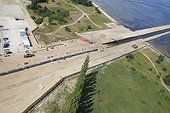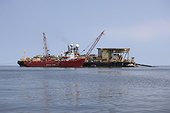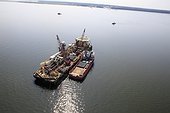Nord Stream Pipeline Reaches European Mainland
- First pipeline string pulled ashore in Lubmin
- Onshore connection projects on schedule
July 5, 2010 | Lubmin | The first pipe string of the Nord Stream Pipeline was pulled ashore on 3 July. “This construction phase was important and exciting for us, not just from a technological point of view. It also has a symbolic significance, as the Nord Stream Pipeline has now reached the European mainland for the first time and, moreover here in Lubmin, the point where WINGAS is planning and already building the natural gas transfer station and the OPAL and NEL onshore pipelines,” says Dr. Georg Nowack, Nord Stream AG project manager for Germany.
Since 28 June, on the pipelay vessel “Castoro Dieci” anchored around one kilometre from the landing point, work has been underway to weld together the approximately twelve-meter-long pipes to form the first pipeline string. The pipeline, which is thus growing at up to 24 meters per hour, is pulled ashore with the aid of a heavy-duty draw winch mounted on land. The winch itself weighs 100 tonnes and in this project it is working with its maximum traction force of around 500 tonnes. This is also necessary in order to pull ashore the pipeline string, which is now around 1,000 metres long and weighs around 2,000 tonnes. Up to around 120 metres inland, this occurs with it floating in a sheet piling trench. Afterwards, the pipeline string is pulled across the ground, supported by large rollers, to the intended final position around 250 metres beyond the shoreline. Once the pipeline string has reached the correct position on land, the floats are removed. The Castoro Dieci then begins pipe laying in a northerly direction by slowly moving away from the landing point, one pipe length at a time. After around five kilometres, the first pipeline string is then left and the pipelay vessel returns to the starting point. Here, it is once again anchored and begins with the production of the Nord Stream Pipeline’s second string. The second pipeline string is scheduled to reach land in mid-July.
From fall 2011, natural gas from the Nord Stream Pipeline will flow into the transfer station which is currently being built. There, it will first be purified and preheated to the right temperature. The quality, quantity and pressure of the natural gas will then be measured. In order to then transport it southward through the 470-kilometer-long Baltic Sea Pipeline Link (OPAL) via Mecklenburg-Western Pomerania, Brandenburg and Saxony to the Czech border near Olbernhau in the Erzgebirge mountains, it will be recompressed to as much as 100 bar after half of the total route south of Berlin.
The construction of the building and the boiler house for the natural gas transfer station is currently in preparation. The laying of the foundation stone already took place in February of this year. Construction of the high-pressure systems in the station, which in future will guarantee transport of up to 55 billion cubic meters of natural gas from the Nord Stream Pipeline, is to begin in November 2010.
Construction work on OPAL has already been underway since September 2009: between Lubmin and the Erzgebirge mountains, all construction sections are being worked on at top speed. Construction is currently proceeding at around 2,500 metres per day. “We are very satisfied with this and we are well on schedule,” says Hans-Georg Egelkamp, OPAL project manager at WINGAS. With a diameter of 1.40 metres, OPAL is the largest natural gas pipeline to be laid in Europe. The pipeline is being built by WINGAS, as commissioned by OPAL NEL TRANSPORT GmbH and E.ON Ruhrgas AG.
Of the 470-kilometre pipeline, 260 kilometres have already been welded. By summer, over half of the line will already have been laid in the ground. Already now, 160 kilometres have been laid.
In addition to OPAL, construction of the North European Gas Pipeline (NEL) is also planned. This is to run from the Nord Stream Pipeline landing point, past Schwerin and Hamburg, to the Rehden gas storage facility in Lower Saxony, thus connecting the Nord Stream to the European pipeline network, just like OPAL.







